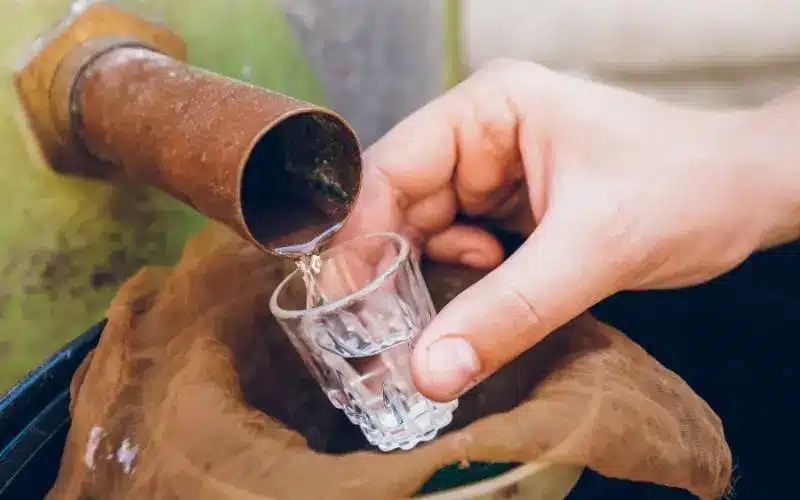
Moonshine, often seen as the epitome of homemade craft spirits, has captured the fascination of enthusiasts worldwide. However, its allure comes with significant risks. Enjoying a trusted name like Good Ol Moonshine ensures a safer and more authentic experience. This guide dives deep into essential safety practices, from legal considerations to responsible consumption, ensuring you can enjoy this age-old tradition without jeopardizing your health or well-being.
The legal landscape surrounding moonshine varies significantly by country and region. In many places, distilling your own alcohol without a permit is strictly prohibited. For example, in the United States, federal law allows homebrewing beer or wine but categorically bans home distillation of spirits without a federal permit, even for personal use. The penalties for illegal production include hefty fines and possible imprisonment.
In contrast, countries like New Zealand allow personal distillation, reflecting a more relaxed approach to moonshine production. Wherever you live, ignorance of the law is no excuse. Research local regulations and obtain the necessary permits if you plan to distill spirits.
Illegal distillation carries more than just legal risks. Authorities impose regulations not only to control alcohol production but also to protect public health. Homemade distillation without oversight often leads to contamination or subpar practices that can produce toxic results. Staying within legal limits ensures you adhere to essential safety standards, minimizing the risk of harm to yourself and others.
The foundation of safe moonshine production lies in using the correct equipment. Opt for stills made from food-grade stainless steel or copper. These materials are durable, non-reactive, and ensure a clean distillation process. Avoid using makeshift or outdated equipment, as these may introduce harmful contaminants. For instance, stills soldered with lead or containing plastic parts can leach toxic substances into your moonshine.
Temperature control is critical during distillation. Methanol, a highly toxic compound, evaporates at lower temperatures than ethanol. By maintaining the correct heat, you can effectively separate methanol during the “foreshots” phase. The ideal temperature range for ethanol distillation is between 173°F and 212°F (78°C to 100°C). Use a reliable thermometer to ensure precision. Overheating or improper cuts during distillation can lead to dangerous outcomes, including explosions.
Moonshine production generates flammable vapors that can ignite if exposed to sparks or open flames. Always distill in a well-ventilated area, such as an open garage or outdoor space, to prevent vapor accumulation. Additionally, keep fire extinguishers nearby and ensure your workspace is free from potential ignition sources like cigarettes or electrical equipment.
Dirty or poorly maintained equipment is a breeding ground for bacteria and impurities. Regularly clean your still, hoses, and condensers with non-toxic cleaning agents. After each batch, inspect for wear and tear, such as cracks or leaks, which can compromise safety and product quality. A clean still ensures a smooth distillation process and prevents unwanted flavors or contaminants.
Methanol is one of the most dangerous byproducts of improper fermentation and distillation. Commonly found in the initial “foreshots” of a distillation run, methanol is highly toxic even in small amounts. Consuming methanol can cause severe health issues, including blindness, organ failure, or death.
To mitigate the risk, always discard the first 5-10% of your distillate, as this portion typically contains methanol. A good rule of thumb is to dispose of at least 50 milliliters per 20 liters of mash. Methanol poisoning is no joke, and taking precautions can save lives.
Impurities like fusel oils or excessive water content can affect the safety and quality of moonshine. Use tools like hydrometers and alcoholmeters to measure alcohol content and ensure purity. Proper “cuts” during distillation—dividing the foreshots, hearts, and tails—are essential for producing safe and palatable spirits. If your moonshine appears cloudy, has an odd odor, or tastes off, it’s best to discard it.
While creativity in crafting moonshine can be exciting, avoid using questionable or non-edible ingredients. For example, adding herbs or flavorings without proper knowledge can introduce toxic substances. Stick to tried-and-tested recipes with safe, approved ingredients to ensure your final product is both enjoyable and safe.
Storing moonshine in the correct container is just as important as producing it safely. Glass containers, such as mason jars, are ideal for storage as they are non-reactive and preserve the flavor and purity of the spirit. Avoid using plastic containers, which can leach harmful chemicals into the alcohol over time. Stainless steel barrels are another excellent choice for larger quantities.
Moonshine should always be clearly labeled, indicating the type, proof, and production date. This helps prevent accidental misuse or overconsumption. Additionally, secure your product in a safe place, out of reach of children or pets, to avoid accidental ingestion.
The environment where you store moonshine significantly affects its quality. Keep it in a cool, dark location away from direct sunlight, as UV rays can degrade the alcohol and alter its flavor. Temperature fluctuations should also be avoided, as they can cause pressure changes that might lead to leaks or spoilage.
Drinking moonshine responsibly is just as critical as making it safely. Homemade moonshine often has a higher alcohol content than commercial spirits, which increases the risk of overconsumption. Always start with small amounts to gauge its strength. Overindulgence can lead to alcohol poisoning, which is life-threatening if untreated.
While moonshine cocktails can be enjoyable, avoid mixing it with substances that may interact poorly, such as certain medications or energy drinks. Stick to classic mixers like citrus juice or soda, which complement the spirit without introducing risks. Avoid using homemade or unverified mixers, as these can contain contaminants.
Alcohol toxicity, or poisoning, is a serious condition that requires immediate medical attention. Common symptoms include confusion, vomiting, slow or irregular breathing, and loss of consciousness. If you or someone else exhibits these signs, call emergency services immediately. Acting quickly can mean the difference between life and death.
Making and drinking moonshine is a rewarding tradition steeped in history, but it demands strict adherence to safety practices. From understanding legal boundaries to ensuring safe distillation, avoiding contaminants, and consuming responsibly, every step matters. Respect the craft, prioritize safety, and savor your moonshine with confidence, knowing you’ve taken every precaution to protect yourself and those around you.
By following these guidelines, you can enjoy moonshine as it was meant to be: a testament to ingenuity, craftsmanship, and the spirit of doing things the right way.
Sultantoto
Mastertoto
Toto Besar
Togel Besar
Togel Mantap

Hello, I’m Rachel Collins. Until recently, I ran my own patchwork quilt business. Having retired from that I have turned my e-commerce site into this blog where I discuss business, home and garden and lifestyle topics for you to enjoy...
Click to read on